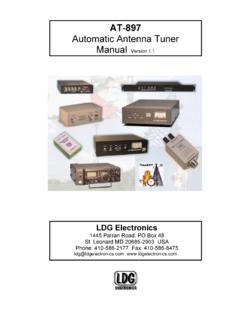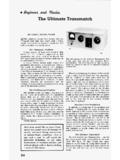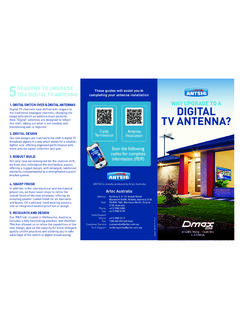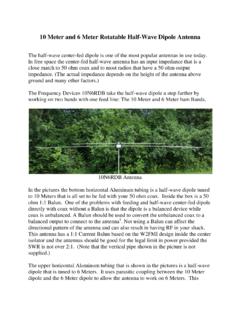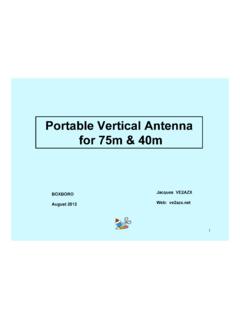Transcription of LDG RBA-4:1Balun LDG RBA-1:1Balun
1 LDG RBA-4:1 balun LDG RBA-1:1 balun Table of Contents Features 1 Specifications 1 Preparation 2 An important word about power levels: 2 Installation 2 Care and Maintenance 6 Technical Support 6 Warranty and Service 6 Introduction Congratulations on selecting the LDG balun . Your LDG balun allows you to connect longwires and antennas fed with ladder line to your LDG tuner. Two versions are available: the RBA-4:1 provides a 4:1 impedance transformation, while the RBA-1:1 has 52 ohm input and output. LDG pioneered the automatic, wide-range switched-L tuner in 1995. From its laboratories near our nation s capitol, LDG continues to define the state of the art in this field with innovative automatic tuners and related products for every amateur need. The RBA-4:1 and RBA-1:1 are valuable accessories for any LDG tuner, extending its usefulness to virtually all types of antennas and transmission lines in amateur use.
2 Features Compact, sturdy construction Standard SO-239 jack for coax input Twist-on binding posts for ladder line, longwire or random wire attachment Can be waterproofed for outdoor use Broadband operation; covers the entire HF spectrum from 30 MHz Handles up to 200 watts continuously Your LDG balun performs two important functions: 1. It provides a convenient connection interface between coaxial cable and either ladder line or a longwire antenna 2. It converts from an unbalanced source ( , a transmitter or tuner with coaxial output) to a balanced transmission line ( , ladder line) In addition, the RBA-1 provides a 4:1 impedance conversion permitting use of higher impedance antennas and transmission lines. Specifications Weight: 6 oz (with enclosure) Frequency Coverage: to 30 MHz Power Range: to 200 watts Easy to weatherproof Size overall: 5 x x inches Impedance transformation 1:1 or 4:1 1 Preparation As it comes from the factory your LDG balun is water resistant.
3 There are neoprene seals under the SO-239 coax socket and the two binding posts. If the balun is mounted with the removable lid (back) facing down (that is, with the writing facing up), it is reasonably water resistant. You can make it completely waterproof and suitable for direct exposure to the weather at any mounting angle for outdoor use if you wish. Simply apply a bead of Silicone caulking material (available at any hardware store) around the back plate seal, and let it dry before use. Waterproof here An important word about power levels: Your LDG balun is rated at 200 watts continuous power input at most. Some ham transmitters and transceivers, and virtually all amplifiers, output well over 200 watts. Power levels significantly exceeding specifications will definitely damage or destroy your LDG balun . If the balun fails under extreme overload, your transmitter and tuner could also be damaged.
4 Be sure to observe the specified power limitations. IMPORTANT SAFETY WARNING Never install antennas over or near power lines. You can be seriously injured or killed if any part of the antenna touches the power line. Always follow this antenna safety rule: the distance to the nearest power line should be at least twice the length of the longest antenna dimension. Installation You will install your LDG balun between your tuner (or transmitter/transceiver if you are not using a tuner) and your antenna. You can attach it directly to the SO-239 output jack of your tuner or transmitter/transceiver, or you can install it remotely at the end of any length of 52 ohm coaxial cable. Direct connection: You can mount your LDG balun directly to the output jack of your tuner using a male-male PL-259 adapter (not supplied). Simply attach the adapter to the balun , then attach the balun to the output jack.
5 Make sure the balun has adequate mechanical support, so it does not place excessive torque on the antenna jack of your tuner or radio. 2 This type of connection is only recommended if the tuner is mounted remotely or the operating position is outdoors. The use of ladder line indoors can sometimes lead to RFI issues near the operating position. Whenever possible, use the remote connection as shown below. Remote connection: RBA-1 4:1 BalunBalancedUnbalancedLDGE lectronicsTunerAntennaLadder Line to antenna You can mount your LDG balun remotely, connecting it to your tuner with any length of 52 ohm coaxial cable of suitable power handling capacity (typically RG-58, or some version of RG-8). Properly soldered PL-259 connectors will be far more satisfactory than crimp-on or solderless connectors. If you mount your balun outdoors and exposed to direct weather, LDG recommends that you waterproof it as described above.
6 RBA-1 4:1 BalunBalancedUnbalancedLDGE lectronicsTunerAntennaLadder Line to antenna52 Ohm Coax(any length) A note about ladder line: unlike coax, ladder line performance can be strongly influenced by conductive elements nearby, such as aluminum house siding, gutters, other wires or the earth. You must take care to route your ladder line correctly, using standoffs and insulators as needed. To avoid a degradation of performance, mount your balun remotely and use coaxial cable to connect to the tuner or radio. Longwire and Random antennas: Longwire and Random antennas are typically elevated wires at least one half wavelength long at the lowest frequency to be used. As a general rule, the higher the better, and the longer the better. Longwire antennas are somewhat directional; the main lobe is along the direction of the wire. Performance of any longwire antenna will depend in large part on the quality of the ground connection.
7 If the Longwire or Random wire is less that one half wavelength, then it is typically referred to as a short wire antenna. For short wire antennas, use a 1:1 balun for best performance. Any Longwire or Random wire must be connected to ground or a counterpoise wire for best results. 3 RBA-1 4:1 BalunBalancedUnbalancedLDGE lectronicsTotunerLongwire antenna (generallyone wavelength or longer)Ground wire (asshort as possible)Antenna support(tower, post, tree, etc)Buried groundsystem(Not to scale) ~TransmitterCoax1/2 wavelength dipoleCenter conductor currentInside shield currentOutside common-mode shield current due tobalanced-to-unbalancedtransition LDG strongly recommends that you use a high-quality, properly installed lightning arrestor in all your antenna feed lines. Theory of operation: Virtually all amateur transmitters and transceivers in use today, and all LDG tuners, are designed with an unbalanced output.
8 This means that the output signal appears on a single conductor referenced to a grounded second conductor. Most amateur transmitters use a pi network output, and LDG tuners employ a switched-L network, both of which feature an unbalance output. These output sections are designed to be used with coaxial cable, an unbalanced transmission line. The signal is carried on the center conductor, 4and the reference ground is the inside surface of the shield1; the two signals are equal in amplitude but 180 degrees out of phase. These two out-of-phase signals cancel each other out along the length of the coax, preventing it from radiating, and delivering almost all of the RF energy to the antenna feedpoint. Many commonly used amateur antennas are balanced antennas; examples include a dipole, and the driven element of a Yagi-Uda array (a Yagi antenna). A balanced antenna features two equal electrical elements driven 180 degrees out of phase.
9 It is common amateur practice to feed such antennas directly with coaxial cable, an unbalanced transmission line. At the interface between the unbalanced transmission line and the balanced antenna, an extraneous current flow is created on the outside of the coax shield. This is called a common-mode current, as it is in the same direction as the signal on the center conductor. This common-mode current has three disadvantages. First, it radiates a signal that can distort the radiation pattern of the antenna. For example, the symmetrical figure eight pattern of a dipole can be distorted into a highly asymmetric blob who s performance is difficult or impossible to predict. Second, this radiation subtracts from the useful RF energy radiated to the receiving station. Third, the RF on the outside of the shield can be conducted back into the transmitter, causing problems such as distorted transmit audio. The term balun stands for balanced-unbalanced.
10 A balun is a matching transformer designed to interface between unbalanced transmission lines and balanced antennas, or between the unbalanced output section of a transmitter or tuner and a balanced transmission line. Some baluns also act as an impedance matching transformer, converting the lower impedance of the transmitter to the higher impedance of certain transmission lines. In principal, you should use a balun at the feedpoint of a dipole where the coax is attached. However, in practice, the diameter of the coax is usually such a small fraction of the feedline length that the effects can be largely ignored2. Normal dipole figure eight radiation patternDistorted radiationpattern due tocommon-modecoax radiation090180270090180270 A more significant problem is using ladder line to feed a high-impedance antenna such as a folded dipole or loop. Ladder line has several advantages over coax that recommend it in some applications.






